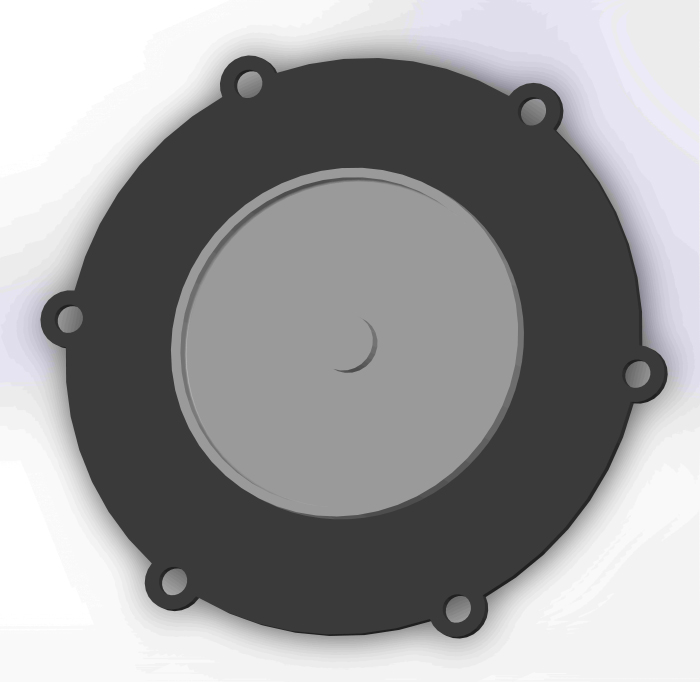GENERAL SEALTECH LIMITED is a high-quality diaphragm product manufacturer that provides comprehensive services and has been meeting the diverse needs of many customers for over 20 years. We produce high-quality diaphragm products to meet your batch and customization needs.
Our tradition is to maintain the shortest turnaround time in the industry, making us your reliable diaphragm production partner. Our engineers check the specified quality through tolerances on dimensions and required performance of the finished product to ensure timely delivery. Provide high-quality products at competitive prices and deliver them on time.
| Product Name | rubber valve diaphragms |
| Materials | Silicone,FKM,EPDM,NBR,etc |
| Brand Name | GENERAL SEALTECH |
| Place of Origin | Hangzhou,Zhejiang,China |
| Product Type | Diaphragm |
| Colors | orange,Recommended black |
| Sample | Available |
| Hardness | 20~90 Shore A diaphragm for regulator |
| Packing | PE Bag+Carton |
| OEM/ODM | Acceptatble |
| Export region | America,Asia,Europe… |
| Export Country | USA,France,Italy,Australia,Cocos (Keeling) Islands,New Zealand,Pitcairn Islands…etc |
| Properties | Fire Resistance,Steam Resistance,Cold Resistance…etc |
| Size | DN max = 2000mm, all other smaller sizes will per customer demands |
| Warranty | 1 Year |
| Function | Seal for Automotive,Valve,Electrical Appliances,etc |
| After-sale Service | Online technical support |
| Certification | KTW,CCS,REACH,National Sanitary Certificate,EN681-1,etc |
| Packaging | carton or according to requirements of the customers |
| Lead time (days) | 7-15 (To be negotiated) |
| Supply Ability | 50000-200000 Piece/Pieces per Month |
Please note: The above table data is for reference only. For specific information, please contact us.
rubber valve diaphragms technology can be widely used in various application fields. It can be used for material control and purification of air,steam,food, and other media, as well as isolation, catalysis, and membrane functions.
If the medium used is corrosive, corrosion-resistant diaphragm materials should be selected;
Necessary protective measures should be taken to minimize damage to objects that come into contact with the already installed diaphragm.
All are made of materials that comply with national safety standards, ensuring the safe use of industrial diaphragms.
rubber valve diaphragms—FAQs Guide
2.What innovations and advancements have been made in rubber valve diaphragms technology in recent years?
3.Are there rubber valve diaphragms designed for quick and easy replacement to minimize downtime in industrial processes?
4.Can rubber valve diaphragms be used in medical devices, and what biocompatibility standards do they need to meet?
5.How are rubber valve diaphragms designed to resist chemical corrosion and degradation in aggressive environments?
6.How do rubber valve diaphragms contribute to the precision and accuracy of pressure control and regulation systems?
7.How do rubber valve diaphragms perform in high-vibration environments, and what measures are taken to ensure their reliability in these conditions?
8.How do rubber valve diaphragms maintain their flexibility and resilience over time, and what factors can lead to wear or degradation?
9.What is the role of rubber valve diaphragms in controlling the flow of aggressive or corrosive chemicals in chemical processing applications?
10.What are the key characteristics that make rubber valve diaphragms suitable for sealing and pressure regulation in different systems?
11.Are rubber valve diaphragms used in safety relief valves and pressure relief devices to prevent overpressure situations?
1.Are there rubber valve diaphragms made from eco-friendly or sustainable materials for environmentally conscious applications?
Yes, there are diaphragms made from eco-friendly or sustainable materials for environmentally conscious applications. These diaphragms are typically made from natural rubber, silicone, or other biodegradable materials. They are designed to be more durable and longer lasting than traditional diaphragms, and they are also designed to be more energy efficient.
2.What innovations and advancements have been made in rubber valve diaphragms technology in recent years?
With the continuous development of technology, rubber valve diaphragms has made a lot of progress, such as:
1. Improved materials: Diaphragms are now made from a variety of materials, including polyurethane, silicone, and other elastomers. These materials are more durable and provide better performance than traditional materials.
2. Improved design: Diaphragms are now designed with more precise tolerances and better sealing capabilities. This allows for better performance and longer life.
3. Improved manufacturing processes: Advances in manufacturing processes have allowed for more efficient production of diaphragms, resulting in lower costs and improved quality.
4. Improved sensing capabilities: Diaphragms are now able to sense pressure, temperature, and other variables, allowing for more accurate control of systems.
5. Improved control systems: Diaphragms are now used in a variety of control systems, including valves, pumps, and other devices. This allows for better control and more efficient operation.
3.Are there rubber valve diaphragms designed for quick and easy replacement to minimize downtime in industrial processes?
Yes, there are diaphragms designed for quick and easy replacement to minimize downtime in industrial processes. These diaphragms are typically made of materials such as rubber, silicone, or PTFE, and are designed to be easily replaced without the need for tools or special equipment. Additionally, some diaphragms are designed with quick-connect fittings to further reduce downtime.

4.Can rubber valve diaphragms be used in medical devices, and what biocompatibility standards do they need to meet?
Yes, diaphragms can be used in medical devices. The biocompatibility standards that diaphragms need to meet depend on the application and the intended use of the device. Generally, diaphragms used in medical devices must meet the requirements of ISO 10993-1, which outlines the general requirements for biocompatibility. Additionally, depending on the application, the diaphragm may need to meet additional requirements, such as those outlined in ISO 10993-5 for cytotoxicity, ISO 10993-10 for irritation and sensitization, and ISO 10993-11 for hemocompatibility.
5.How are rubber valve diaphragms designed to resist chemical corrosion and degradation in aggressive environments?
Diaphragms are designed to resist chemical corrosion and degradation in aggressive environments by using materials that are resistant to the specific chemicals present. Common materials used for diaphragms include fluoropolymers, such as PTFE, FEP, and PFA, as well as elastomers, such as EPDM, Viton, and Neoprene. These materials are chosen for their chemical resistance, as well as their ability to withstand extreme temperatures and pressures. Additionally, diaphragms may be coated with a protective layer of a corrosion-resistant material, such as a fluoropolymer or a metal, to further protect them from chemical attack.
6.How do rubber valve diaphragms contribute to the precision and accuracy of pressure control and regulation systems?
Diaphragms are used in pressure control and regulation systems to provide a precise and accurate control of pressure. They are used to separate the pressure sensing element from the process fluid, allowing for a more accurate and repeatable measurement of pressure. The diaphragm also acts as a barrier to prevent contamination of the sensing element, which can lead to inaccurate readings. The diaphragm also helps to dampen pressure fluctuations, providing a more stable and consistent pressure control.

7.How do rubber valve diaphragms perform in high-vibration environments, and what measures are taken to ensure their reliability in these conditions?
Diaphragms are designed to be highly reliable in high-vibration environments. To ensure their reliability, measures such as using thicker diaphragm material, using multiple layers of material, and using dampening materials such as rubber or foam are taken. Additionally, the diaphragm should be securely mounted to the structure to prevent it from vibrating excessively. Finally, the diaphragm should be inspected regularly to ensure that it is not damaged or worn out.
8.How do rubber valve diaphragms maintain their flexibility and resilience over time, and what factors can lead to wear or degradation?
Diaphragms maintain their flexibility and resilience over time by being made of materials that are resistant to wear and tear. Common materials used for diaphragms include rubber, silicone, and polyurethane. These materials are designed to be durable and flexible, and can withstand a wide range of temperatures and pressures.
Factors that can lead to wear or degradation of diaphragms include exposure to extreme temperatures, exposure to chemicals, and physical damage. Additionally, diaphragms can become brittle over time due to age and exposure to the elements. To prevent wear or degradation, it is important to inspect diaphragms regularly and replace them when necessary.
9.What is the role of rubber valve diaphragms in controlling the flow of aggressive or corrosive chemicals in chemical processing applications?
Diaphragms are used to control the flow of aggressive or corrosive chemicals in chemical processing applications. They act as a barrier between the chemical and the process equipment, preventing the chemical from coming into contact with the equipment and causing corrosion or other damage. Diaphragms are also used to regulate the flow of the chemical, allowing for precise control of the process.

10.What are the key characteristics that make rubber valve diaphragms suitable for sealing and pressure regulation in different systems?
As a professional rubber valve diaphragms manufacturer, we believe that its key features include:
1. Flexibility: Diaphragms are flexible and can be designed to fit a variety of shapes and sizes. This allows them to be used in a wide range of applications.
2. Durability: Diaphragms are made from strong materials that can withstand high pressures and temperatures. This makes them suitable for use in high-pressure systems.
3. Low Maintenance: Diaphragms require minimal maintenance and can be easily replaced when needed.
4. Low Cost: Diaphragms are relatively inexpensive compared to other sealing and pressure regulation solutions.
5. Versatility: Diaphragms can be used in a variety of applications, from automotive to industrial.
11.Are rubber valve diaphragms used in safety relief valves and pressure relief devices to prevent overpressure situations?
Yes, diaphragms are commonly used in safety relief valves and pressure relief devices to prevent overpressure situations. The diaphragm is a flexible membrane that is designed to open when the pressure inside the device reaches a certain level, allowing the pressure to be released.
Tags: thomas pump diaphragm,whale gusher pump diaphragm,2004 yfz450 accelerator pump diaphragm,fuel pump diaphragm,hozelock air pump diaphragm

